An easy Recap
Welcome to 2024, a year where the lines between the digital and physical worlds blur more than ever. Here at GLADTOBE, we understand that today’s marketing is no longer a one-way street. It’s an intricate play of technology and creativity, where online and offline experiences seamlessly intertwine.
Your brand’s journey through this diverse landscape might seem overwhelming, but no need to worry. GLADTOBE is here to guide you.
We’ve sifted through the noise, analyzing over 20 reports so you wouldn’t have to.
Don’t have time? Have a quick look here for the summarized version of all trends:
The transformation from polished content to authentic, audacious storytelling marks a shift in how brands connect with their audience. Social media platforms, particularly TikTok, have revolutionized the discovery process, making it imperative for brands to be dynamic and culturally relevant.
The blending of traditional and digital mediums underscores the need for a nuanced approach to marketing. As streaming giants like Netflix and Disney adapt with ad-supported models, and OTT (over-the-top) media services gain prominence, the importance of understanding diverse audience behaviors becomes paramount.
The surge in social commerce and the ‘shoppertainment’ phenomenon reveal a significant opportunity for brands to leverage social platforms for sales and engagement. Concurrently, the rise of audio marketing, from viral TikTok sounds to the growing influence of podcasts, opens new avenues for creating immersive brand experiences.
The rise of UGC (user generated content) and influencers reflects a democratization of content creation, emphasizing authenticity and trust. Brands that successfully integrate these elements into their strategies can expect to forge deeper connections with their audience.
The integration of AI and machine learning in data analysis, along with the challenges in measuring ROI and utilizing data effectively, underscore the need for sophisticated data strategies.
Would you like to see all of the data insights in detail? Keep scrolling down.
The Dynamic Shift in Content Consumption
Gone are the days of passive scrolling. Today’s social platforms are creative arenas where users are both creators and consumers – ‘prosumers’, if you will. A study from Boston Consulting Group underscores this, revealing that a whopping 79% of APAC shoppers actively engage in conversations about their purchases. TikTok takes this further; 71% of its users take action after watching a video. The trend is clear: content today needs to spark a thought, a laugh, or a conversation. Discover why engaging content is key in digital marketing strategies.
CHANGING CONTENT STANDARDS
The essence of content has evolved from polish to purpose. Adobe’s 2023 Digital Trends Report reveals an intriguing paradox: while 79% of senior APAC marketing executives report a surge in content demand, a mere 25% feel confident in their content’s effectiveness.
Brands can create an abundance of content, but if it doesn’t inspire a reaction then it won’t make a difference. TikTok’s estimates that brands spend up to 43% of their marketing budget on content, yet only 23% of CMOs feel they are producing the right content for the right audience, at the right time and in the right format.
FULL-FUNNEL ENGAGEMENT STRATEGIES
The mid-funnel, once a marketing afterthought, is now pivotal. Brands are no longer just storytellers; they’re culture creators, crafting narratives at the pace of platforms like TikTok, in which research shows that when advertisers run brand and performance campaigns simultaneously, they witness 33% higher conversion rates and 36% less cost per action. Ogilvy Social Media Trends report also highlights a dramatic shift in media allocation, with a 222% year-over-year increase in engagement-first campaigns.
As engagement and consideration take center stage, VMLY&R’s report highlights a critical shift towards KPI’s. Deeper engagement metrics like clicks, following and sharing are the better indicators of consumer interest and impact, more likely to influence purchasing decisions.
THE NEW CREATIVE CONNECTION
Vulnerability is the new cornerstone of connection. In a world where consumers are inundated with content, brands that showcase a ‘work-in-progress’ ethos resonate more profoundly. It’s about creating content that doesn’t just exist but evokes a reaction, a connection. It’s a strategic pivot from perfection to progress, from finished to evolving. No longer just sponsors or advertisers, brands must step into the role of creators themselves.
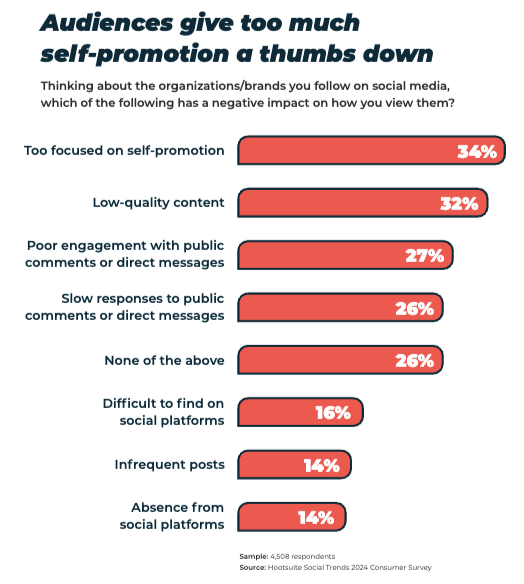
THE ROLE OF CLOSED SOCIAL COMMUNITIES AND DEEP ENGAGEMENT
In the shadows of public platforms, closed social communities are emerging as drivers of deep engagement. VMLY&R’s 2024 Social report highlights the importance of these spaces in fostering authentic connections.
Connecting with culture is essential for creative work, especially on platforms that contain a huge amount of content. Social is not like TV where anybody who can pay will have a role to play,. If you’re not interesting enough, it’s goodbye. The algorithm elevates what’s interesting. It lets sub-trends become major trends.
As SemRush’s Report advises, focusing on content that can be widely shared is your way into increasing brand visibility.
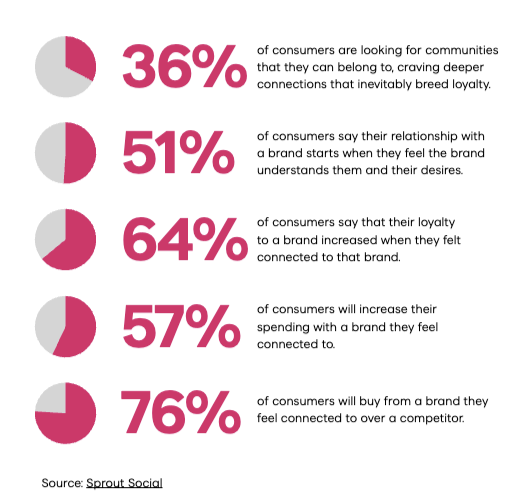
Questioning your content strategy?
It’s time to align your marketing budget with the evolving digital landscape for impactful engagement.
Navigating the Shift from Search Engines to Search Functions
Search engines like Google, Baidu, and Naver have been synonymous with online discovery. However, platforms like TikTok are redefining this space, not as search engines, but as ecosystems equipped with powerful search functions. This distinction is critical as it encapsulates a shift from searching the vast internet to navigating a curated, platform-specific universe.
INSPIRATIONAL DISCOVERY
GlobalWebIndex’s research reveals a fundamental change: the quest for information has evolved into a pursuit of inspiration. This paradigm shift is reshaping how brands position themselves online. In 2018, a query for a product or brand would lead you to Google. Now, the journey often begins and flourishes within the social media landscape, offering an immersive, inspiration-driven experience.
TikTok, a platform once synonymous with entertainment, is now redefining the search ecosystem. Ogilvy’s 2024 Media Trends report highlights a significant trend: TikTok is integrating ad placements within its search results, directly challenging Google’s long-held dominance.
Marketers leveraging TikTok’s unique capabilities can enhance visibility and stay ahead in the rapidly shifting digital landscape.
This evolution demands a more agile and creative approach from brands, as the battleground for consumer attention shifts from search engine result pages to the vibrant, video-centric world of TikTok.
SOCIAL MEDIA AS THE NEW FRONTIER FOR DISCOVERY
The role of social media as a discovery platform is no longer just supplementary; it’s becoming central. The State of Social report highlights that approximately 76% of consumers now use social media to search for products, brands, and experiences. This staggering statistic is not just a trend but a clarion call for brands to realign their strategies to where their audiences are actively seeking, discovering, and engaging.
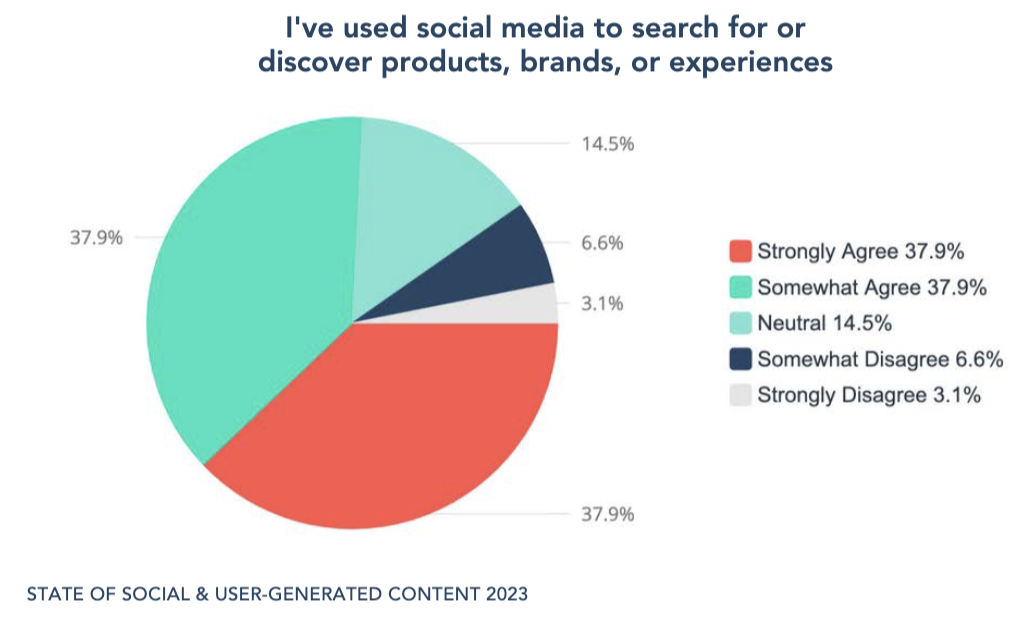
Evolving Touchpoints in Marketing: Beyond Repurposing to True Engagement
It’s not just about choosing between traditional and digital anymore; it’s about blending them for maximum impact. The amount of touchpoints has expanded, demanding more than just repurposing content across platforms. Today’s marketers are tasked with creating content that is native to each medium, harnessing the power of collaboration, and igniting conversations that bridge the gap between online and offline worlds.

DIVERSE MEDIA, DIVERSE STRATEGIES
Consumers crave variety. About 68% are watching content on multiple formats, per YouTube Culture. This trend is a loud wake-up call for brands to diversify their media plans or risk getting left behind.
Marketers are facing a landscape where touchpoints are proliferating at an unprecedented rate. This increase isn’t just overwhelming; it’s reshaping the fundamental approach to marketing. The content that works for a TV commercial often falls flat on social media, requiring a more nuanced and platform-specific approach.
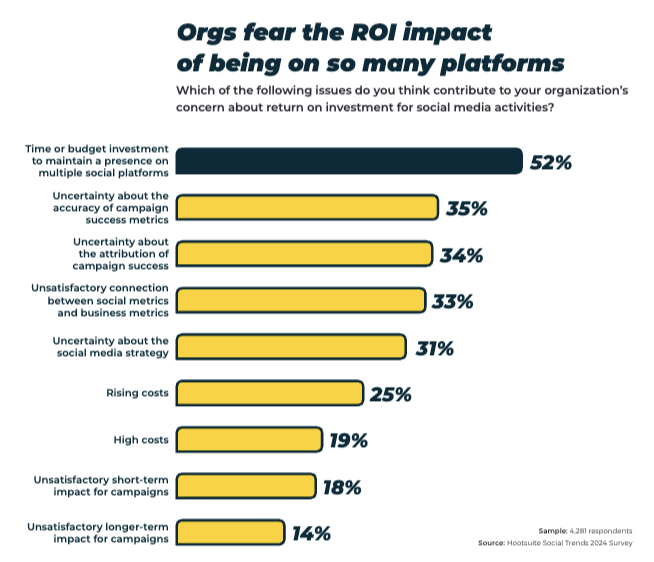
THE AGE OF CONNECTED AND SMART DEVICES
Programmatic channels like digital out-of-home (DOOH), connected TV (CTV), and in-game advertising saw notable growth in adoption and investment. For example, by the end of 2023, it’s predicted that revenue in the in-game advertising market will reach €2.86bn, then rise at a compound annual growth rate of 12.62% resulting in a projected market volume of €4.60bn by 2027.
One of the biggest trends of the year was the growing move toward integrating newer channels with traditional media to drive impactful marketing strategies. For example, UK spend on CTV grew 9.5% in 2023, and investment in this channel, which can be run alongside linear TV efforts, is expected to grow by 16.7% in 2024.
EMBRACING CREATIVITY IN EACH MEDIUM
The surge in touchpoints necessitates a surge in creativity. It’s not just about being present on various platforms; it’s about being impactful. For instance, Connected TV and gaming platforms have opened new avenues for engaging audiences. Learn strategies for maximizing creative impact across diverse marketing touchpoints.
Gaming, with its 96% penetration among Gen Z, while Connected TV is the fastest growing form of internet medium at 10.5% growth per annum reaching 30.4% of current internet users.
Smart Home devices are also growing, reaching 13.8% of online users, 17% year on year growth.
The convergence of offline and online marketing is another pivotal trend. Outdoor advertising, for example, is no longer just about visibility; it’s about sparking online conversations.
ENGAGING THE OLDER DEMOGRAPHIC DIGITALLY
Think older generations aren’t online much? Think again. Those aged 55–64 are logging an average of over five hours online daily. Connected TV and Smart Home devices are seeing a boom, with CTV growing at 10.5% annually (The Pace of Progress). It’s a ripe market for brands that understand how to tap into it.
THE RISE OF DIGITAL CONTENT CONSUMPTION
The numbers speak for themselves. YouTube’s advertising audience is now over 2 billion, growing almost 12% in just a year. Instagram isn’t far behind, with an audience nearing 1.5 billion, marking a 21% increase (The Pace of Progress). And let’s not forget TikTok, with a user base of 885 million adults and counting. These platforms aren’t just growing; they’re evolving how we consume content.
GWI research also reveals that 7 in 10 working internet users (16-64) are now willing to pay for digital content with Video and Media being some of the top choices.
Social media usage has continued to grow in 2024, while radio, podcasts, television, and CTV/ATV usage have remained relatively stable.
REACHING A CROSS-DISCIPLINARY AGENCY
In response to these multifaceted shifts, brands are encouraged to reach for cross-disciplinary agencies, encompassing analytics, research, creativity, and platform expertise. This holistic approach ensures that every aspect of the content supply chain is optimized for maximum impact. (VMLY&R 2024 Social).
Shoppertainment
The landscape of online shopping is undergoing a revolutionary change, dubbed ‘Shoppertainment.’ This convergence of entertainment and shopping, primarily on social media platforms, is redefining the consumer purchase journey, driving sales, and enhancing brand engagement.
SOCIAL COMMERCE EVERISING
Predicted to reach over $2.9 trillion by 2026, social shopping sales are transforming how consumers interact with brands.
Businesses active on social media see an average of 32% more sales compared to those without a social presence.
CONSUMER SHIFT TOWARDS SOCIAL SHOPPING
A significant 53% of consumers express intentions to shop more on social media platforms, signaling a global shift in purchasing habits. With 71% of consumers preferring online shopping, platforms like TikTok have become key for reviews and customer feedback, influencing purchase decisions. The ‘TikTok made me buy it’ phenomenon exemplifies this, where effective branding on the platform drives consumers to action.

THE IMPACT OF DEALS, DISCOUNTS, AND PLATFORM DOMINANCE
Deals and discounts are primary motivators for social commerce, followed by the ease of purchase and exclusive offers. Platforms like Facebook and Instagram dominate social commerce, with Facebook leading at 33% and Instagram at 24%. However, in markets like China, TikTok surpasses them with a 34% lead.
THE CHANGING DEMOGRAPHICS OF ONLINE SHOPPING
Interestingly, the demographic engaging in online shopping is widening. There’s been a 57% rise in baby boomers using TikTok since Q2 2021, and they’re more likely to have purchased online in the past week than Gen Z. This trend suggests a lucrative and untapped market for brands, emphasizing the need for strategies that cater to diverse age groups.
ADVERTISING REVENUE TRENDS
The year-over-year ad revenue growth in Q3 2023 showcases varied performances among major platforms, with Amazon at 9.4%, Meta at 8.2%, and Spotify at 5%, while Snapchat experienced a decline of 7.5%(Ogilvy Social Media Trends).
Platforms like Facebook and Instagram remain dominant in social commerce, with Facebook leading at 33% and Instagram at 24%. However, TikTok is making significant strides, especially in markets like China where it leads with 34%(WTC Social Commerce).
The Evolution of Audio Marketing
Audio marketing is experiencing a renaissance, shifting from catchy jingles to the viral potential of platforms like TikTok. This evolution reflects a broader trend in marketing: the diversification of formats and the exploration of new, immersive ways to engage audiences. From the nostalgia of radio to the interactive nature of digital platforms, audio marketing is more dynamic and influential than ever. Explore the evolution of marketing across audio and digital platforms.
TikTok's Revolution in Audio Engagement
The era of catchy jingles has evolved into a dynamic audio landscape on platforms like TikTok. Here, audio isn’t just background music; it’s a central feature of content. For instance, Nestlé Pure Life Water’s T-Pop track resulted in the number one trending song on TikTok and inspiring 1.7 million videos, demonstrating the power of original audio content in today’s digital age.
Podcasts: The Rising Star of Digital Platforms
Digital audio, especially podcasts, is rapidly gaining popularity as consumers seek alternatives to visual content. This shift presents a unique opportunity for brands to integrate into cultural conversations. Podcasts offer a platform for deeper engagement, aligning with significant events and preferences for audio media – they are perceived as more thought-provoking and influential compared to radio ads, with 65% of respondents paying a lot of attention to podcast ads.
Integrating Video and Audio in Marketing
The use of video in marketing remains robust, with 79% of marketers investing in video in 2023. Combining video and audio content is increasingly seen as an effective strategy to make brands stand out. With 66% of consumers believing that brands using both video and audio are more noticeable, video podcasts are gaining traction, particularly on platforms like YouTube – 32% of Americans now favor video podcasts over audio-only versions, with this preference even higher among younger audiences.
Explore the potential of audio in your marketing strategy.
Discover how GLADTOBE can help you create engaging audio content that resonates with your audience and amplifies your brand’s voice.
UGC and Influencers: a response to the need of authenticity
Modern technology has democratized content creation, empowering individuals to become influencers, creators, and even entrepreneurs. Platforms like YouTube, TikTok, Instagram, and Twitch have revolutionized how content is created and consumed. And it became the consumer preference: 80% prefer seeing photos of real customers over stock photos.
82% of people (online adults aged 18-44) reported posting video content online over the past 12 months. (YouTube Culture)
People are already creating content, you just need to make your brand loved enough to be part of that creation.
THE RISING INFLUENCE OF VIDEO CONTENT
Video content has become a dominant force in the digital realm, with influencer videos accounting for nearly 27% of watched content weekly. A staggering 92% of people aged 16 to 64 watch some form of video content each week, highlighting the increasing role of video in digital marketing strategies. As marketing budgets face constraints, with around 36% decreasing in 2023, the focus on cost-effective and impactful video content becomes even more crucial and it can be easily achieved with UGC Creators.
THE POWER OF UGC AND INFLUENCER TRUST
UGC is a goldmine for engagement, with 82% of adults aged 18-44 posting video content online in the past year. The trend towards UGC highlights a shift towards authenticity in marketing. Consumers increasingly trust and relate to content created by influencers over traditional brand advertising. In fact, 37% of consumers trust social media influencers more than brands, and 32% find influencer content more relatable.
RATINGS, REVIEWS, AND CONSUMER PREFERENCES
Ratings and reviews play a critical role in conversion rates, recognized by over 69% of marketers. However, a significant 93% aren’t fully leveraging the power of UGC, indicating a gap in strategy implementation. Moreover, 80% of consumers prefer seeing photos of real customers over stock photos, emphasizing the demand for genuine, relatable content.
Is your brand ready to embrace the power of UGC and influencers in your digital marketing strategy?
Discover how GLADTOBE can help you tap into this authentic and engaging world to enhance your brand’s connection with its audience.
The Growing Complexity of Data in Marketing
In 2024, the marketing world is navigating a complex data-driven landscape. Integrating and analyzing diverse data sets has become crucial for developing effective strategies. However, challenges abound. Only 55% of organizations globally have a clear overarching data strategy, highlighting a gap in data utilization and strategy formulation. This lack of a coherent strategy is more pronounced as third-party cookies phase out, pushing brands to refine their first-party data approaches.
OVERCOMING THE CHALLENGE OF ROI MEASUREMENT
A significant challenge facing marketers is the measurement of ROI, particularly for visual content across various channels. With 22% of marketers lacking a clear methodology to determine what content will convert, there’s a pressing need for more sophisticated tools and strategies to effectively gauge the impact of marketing efforts.
GRANULARITY OF DATA IN MEDIA
With the increasing granularity of data, especially from connected TVs, there are significant opportunities for understanding complex audience behaviors and shaping advertising or content strategies more effectively. However, despite the availability of this data, many in the media industry are not fully leveraging it due to resource constraints, lack of expertise, and/or privacy concerns.
EMBRACING FIRST-PARTY DATA AND AI-DRIVEN ENHANCEMENT
As third-party cookies face deprecation, the focus is shifting towards first-party data strategies. This shift is critical for brands aiming to maintain relevance and effectiveness in their marketing efforts. Simultaneously, the application of machine learning and generative AI to data sets is revolutionizing how we understand and utilize this information. These technologies are enhancing the ability to uncover hidden patterns, refine data, and suggest new strategic directions.
AI'S EXPANDING ROLE IN MARKETING
Generative AI and machine learning are increasingly used in social media for data-driven suggestions and content optimization. About 60% of consumers are open to content created using AI, underscoring the growing acceptance and potential of AI-enhanced creativity in marketing. Furthermore, AI’s role in contextual advertising is enabling brands to deliver hyper-personalized content, ensuring more impactful and efficient campaigns.
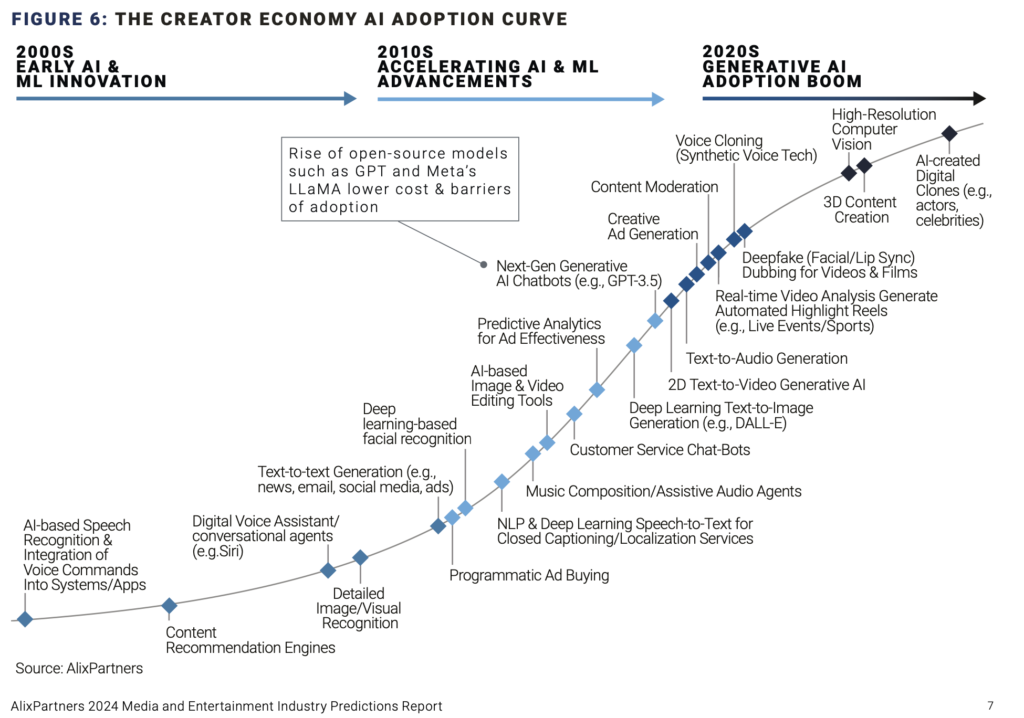
CONSUMER RESPONSE TO AI
Consumers are showing a growing interest in AI-generated content. Over 1.7 billion views were recorded for videos related to or using generative AI tools in 2023. 76% of people believe technology can make the world a better place, and 59% trust AI to act in humanity’s best interest. However, human qualities like critical thinking, love, empathy, diplomacy, intuition, and compassion are still highly valued and not easily replaced by technology.
Conclusion: Embracing the Future of Marketing in a Culture-First World
2024 challenges brands to be more than just sellers of products or services. It invites them to be shapers of experiences, connectors of cultures, and architects of a better future. From the rise of authentic storytelling in content creation to the nuanced blend of traditional and digital strategies, each trend we’ve explored signals a pivotal change in consumer engagement.
Social commerce and audio marketing are emerging as powerful forces, demanding innovative approaches. The influence of UGC and influencers, fueled by authenticity, is reshaping brand-consumer dynamics. In this landscape, the role of data-driven strategies and AI becomes critical, offering insights into evolving consumer conversations from financial literacy to mental wellness.
The key for brands to succeed in 2024 lies in their adaptability and insight. It’s about embracing these trends with a strategy that’s agile, culturally attuned, and data-informed. Brands poised to navigate this landscape with precision and empathy will not only connect more effectively with their audience but also pave the way for sustained growth in a rapidly evolving digital world.
Step into the future of marketing with GLADTOBE. Embrace these transformative trends to craft a marketing strategy that resonates deeply and drives success in 2024 and beyond.












